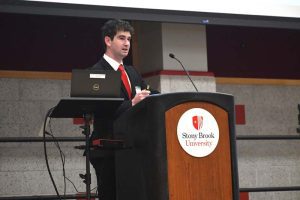By Sabrina Artusa
After the 2023 fire, the Tesla Science Center in Shoreham is on its way to rebuilding. In November 2023, the center was in the process of a $20 million restoration: the culmination of fundraising and a grassroots effort to turn the historic and dilapidated property into something educational and productive.
While the fire poses an unfortunate hurdle to the center’s reopening, the board of directors are continuing to move ahead to offer at least a part of the center to the public: the Visitors Center.

“It is the beginning of the whole property, but right now it is everything,” said Marc Alessi, executive director. “It is the advertiser of what this will be. There is going to be one exhibit and a classroom and they can hold events and field trips.”
He expects to get the Visitors Center to open in 2026, having already secured a contractor to work on the building at the end of April.
The nonprofit has already raised $14 million from across the country, in addition to federal grants that they will receive once the work those grants are designated for is complete. The fire, however, added $3.5 million to their original estimate of $20 million, as well as another year, at least, to their timeline until reopening.
The Tesla center’s history has been spotted with difficulty. It took over a decade for the property to be secured, and then several years before enough money was raised to hire engineers and apply for permits.
The historic nature of the buildings as well as the fact that it is situated on a brownfield, a property that could be contaminated by past use, contributed to making the center “the most complicated museum project in the country right now.”
The site is not ideal, but in order to honor the 120-year-old building and the significance of the location to Tesla’s legacy, the complicated construction is worth it to Alessi, the rest of the staff and the board of directors as well as over 30,000 people who donated to the cause. “If it wasn’t Tesla’s historic lab, it wouldn’t be happening on this site…This is hallowed ground and a historic site in the making,” Alessi said.
To honor the historic nature of the buildings, Alessi said they had to find a contractor with expertise in historic renovations. Their last contractor fell through and denied the insurance claim after the fire, he said.
Now, the center has recently appointed four new board members with diverse backgrounds in an effort to expand the center’s mission. Matt Inman, one of the initial advocates for the center, cartoonist and creator of the popular card game “Exploding Kittens” is bringing “a new way of thinking“ and “a network we wouldn’t have known of,” said Alessi.
Kara Cannon, CEO of Enzo Biochem; Matt Domo, an innovator with a background in technology; and Romain Murenzi, a professor of physics at Worcester Polytechnic Institute with experience in science policy, joined the board of directors last month.
“[Murenzi] has experience setting up science programs in nations across the world. If we want to be a global science center we have to get people like this involved who have that reach; and it will be an international board eventually,” Alessi said.
The center is expected to bring international visitors – perhaps tourists who are visiting New York City but make the trip to Long Island to visit the site of Tesla’s abandoned lab with all the exhibits and technologies it has to offer. Board members expect 180,000 visitors a year.
Once the museum is established, they would like to employ traveling exhibits in the future, where other museums borrow from their niche collection. The museum will tell Tesla’s story but will be equally focused on new ideas and technologies. Alessi said, “[Tesla] was a ‘futurist. That is the kind of thinking we want to embrace and celebrate.”






































